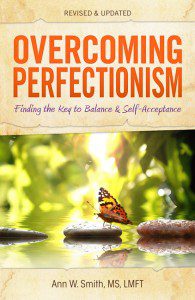 Too many of us strive for perfection, which is not loving to yourself. And it can keep you from letting love in. Today’s guest is Ann Smith is the Executive Director of Breakthrough at Caron. Her updated book, Overcoming Perfectionism: Finding Balance and Self-Acceptance, was released in March. Here’s some insight into how to recognize and alter patterns of being a perfectionist.
Too many of us strive for perfection, which is not loving to yourself. And it can keep you from letting love in. Today’s guest is Ann Smith is the Executive Director of Breakthrough at Caron. Her updated book, Overcoming Perfectionism: Finding Balance and Self-Acceptance, was released in March. Here’s some insight into how to recognize and alter patterns of being a perfectionist.
Too Perfect For Love?
Perfectionism may not be good for your relationships
by Ann Smith
Alexa was born a perfectionist. It wasn’t a problem, just something that was noticeable to her parents, siblings and family. When she was little she enjoyed coloring in the lines, arranging her toys in a symmetrical line and dressing her dolls just right. As she grew, she developed a tendency toward organization, keeping schedules and planning ahead. Alexa’s pattern is one that I call Overt Perfectionism in my book Overcoming Perfectionism: Finding Balance and Self-Acceptance, because it is visible to others.
Although in some ways it appears to be an advantage in life, perfectionism isn’t always a good thing.
In school or at work, perfectionism can be an asset; however, perfectionists will often have unexpected challenges in their friendships, sibling relationships and eventually in their intimate relationships. At 34, Alexa sought help after her second marriage seemed to be falling apart. She worked very hard at being a good spouse and she couldn’t cope with failing at another relationship. Her struggles were not something she could fix by being perfect. In fact, being perfect may have caused them.
The following behaviors and traits are noticeable in the overt perfectionist:
• Critical of others (whether directly or indirectly)
• Defensive when they feel criticized
• Determined to avoid making mistakes and when they do, they hide or deny them
• Guarded about showing any flaws or weaknesses
• Unable or unwilling to ask for help with personal concerns
• Afraid of vulnerability and thus have a fear of intimacy
• Very particular about how things are done
• Focused on tasks and things more than on people
• Self conscious and preoccupied with what others think of them
Imagine yourself on the opposite side of a relationship with a perfectionist who exhibits all or even a few of these traits. The irony is that for a perfectionist, the harder he tries to be a good partner, the more alone his partner feels. They may be doing a great deal to manage a job, home, children and more, but not necessarily the things that a partner really needs and wants. The partner of a perfectionist may feel the absence of true closeness, equality and interdependence (reliance on one another in a balanced way). They will often see the perfectionist as critical, dissatisfied, unreachable, unavailable and without emotional needs. The perfectionist also ends up feeling alone and unappreciated and cannot understand what they are missing. It is devastating to devote oneself to being the best and finding out that it is not seen or appreciated.
With help and soul searching Alexa discovered that although her past and current partner found her interesting and dependable in the beginning, they did not feel emotionally connected to her. Because of her perfectionist pattern, Alexa had been attracted to partners who were at first in need of her stability, competence and independence and then later resented it. She was certain that she did not cause all of the problems in these relationships, but she was ready to face her personal role in her struggles.
She began a process of gradual change which may be helpful to others with this pattern:
1. She asked her partner, friends and family to be honest with her about how she functioned in each relationship. She discovered that the people she cared about saw her as “one up” in their relationship with her. They told her that she was always ready to help and lead but not able to receive help or to be intimate. They often felt less than her and wished she would ask them for support. They wanted to be closer to her and were not judging or criticizing.
2. She began to notice her own moments of weakness – times that tend to draw us closer to others if we are willing to share our concerns and needs. This was a challenge for Alexa since showing flaws and making mistakes were uncomfortable and even distressing. As she worked at being more real, she noticed that people around her were interested in her and cared about her feelings.
3. Alexa began to accept others as they are which increased her anxiety for a while. She found that she was not giving advice or making suggestions to others about their lives. She wasn’t sure of what her role should be if she was not pleasing them. Her friendships were becoming more balanced and equal.
4. Over time she began to embrace who she was – her essence, rather than her performance or appearance. Although she was still a bit of a perfectionist, she was softening, depending more on others, trying new things and having fun.
The key to changing a perfectionist pattern is to view it as a shift rather than a total transformation. It is more likely to happen if you put the focus on the rewards of becoming real. Everyone has flaws and that fact connects us with humanity. Pretending we don’t leads to isolation and at best, conditional love. Deep down, we all want to be loved and accepted for who we are. The change starts with acknowledging our humanness and accepting the best and worst of who we are. Self improvement is a choice, not a mandate. Some things about us will never change and other traits may be altered by life experiences. In the meantime you are good enough for today – perfectly imperfect.
This content originally appeared on PsychologyToday.com
***************
Join the Self-Love Movement™! Take the 31 Days of Self-Love Commitment and get my book, How Do I Love Me? Let Me Count the Ways for free at http://howdoiloveme.com. Read my 2013 31 Days of Self-Love Posts HERE. Join the Self-Love Movement™! on Facebook.
Please leave comments under my posts so we can stay connected.

